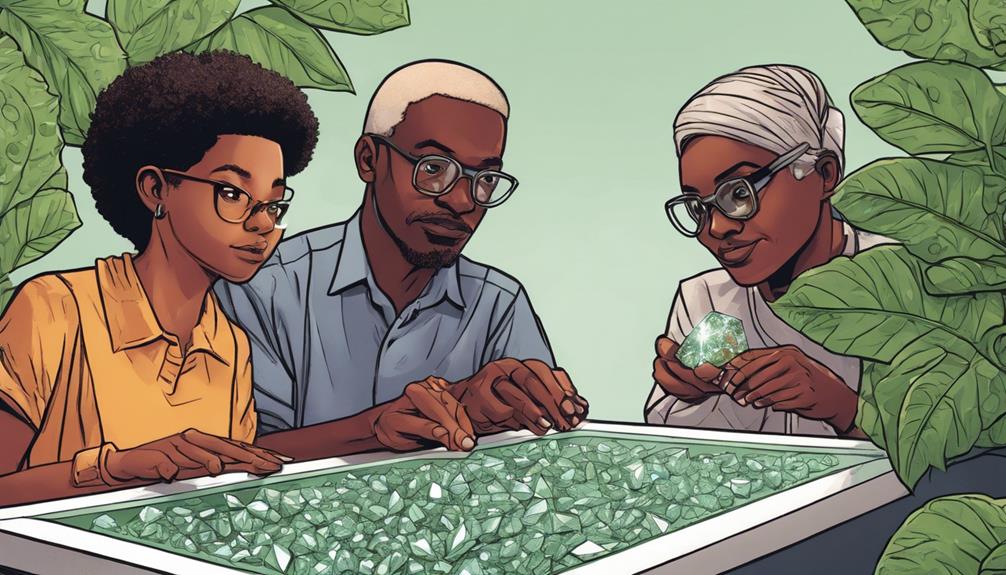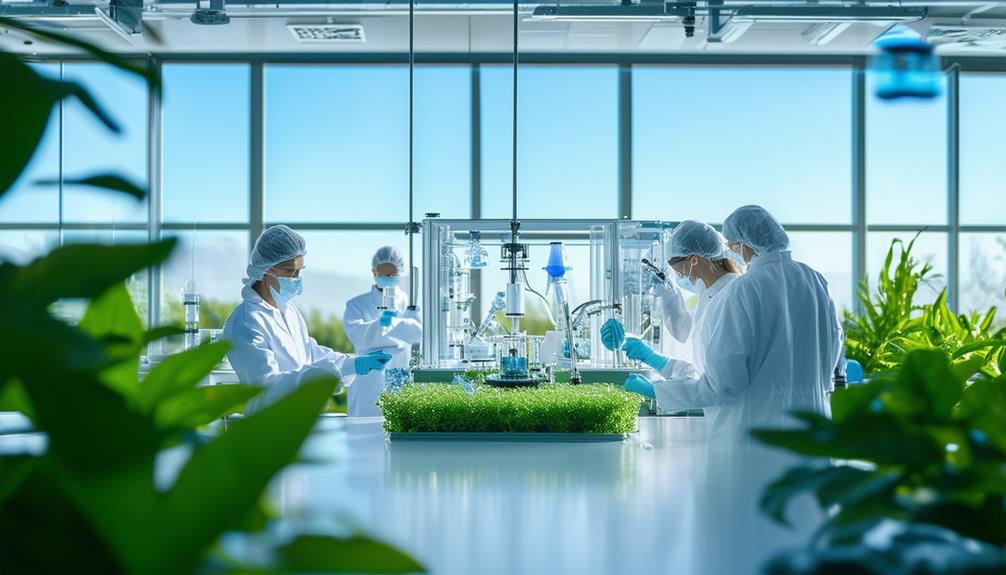Article Contents
Lab-grown diamonds are acclaimed for their significantly reduced environmental impact compared to mined diamonds. They produce approximately 0.025 to 0.035 kg of CO2 per carat, making them a more sustainable choice.
These diamonds are produced using innovative technologies that incorporate renewable energy sources, including solar and wind power, which contribute to their lower carbon emissions. The production processes are designed to be energy-efficient and minimise waste through the use of closed-loop systems and recycling of materials.
This approach not only appeals to environmentally conscious consumers but also reflects the industry's dedication to sustainable practices. Lab-grown diamonds combine aesthetic appeal with environmental responsibility, offering a compelling choice for those seeking both beauty and ethical assurance.
Key Points
- In the Asia-Pacific region, lab-grown diamonds are produced with the smallest carbon footprint, emitting only 0.025 kg of CO2 per carat.
- Implementing renewable energy sources in diamond manufacturing processes can significantly reduce CO2 emissions.
- Compared to natural diamonds, lab-grown diamonds typically have a lower carbon footprint.
- Diamond production in the Middle East and Africa records the highest carbon footprint, with emissions reaching 0.035 kg CO2 per carat.
- Environmental impacts are further minimised through strategies that focus on material reuse and recycling, effectively reducing waste in diamond production.
Regional Production Variations
Lab-grown diamonds exhibit varying carbon footprints across different regions, reflecting the distinct technological and environmental strategies employed. In North America, the production processes achieve an average carbon footprint of 0.028 kg CO2 equivalent per carat, a testament to the region's focus on innovative and sustainable practices. This aligns with consumer preferences for high-quality, environmentally friendly products.
Europe demonstrates a similar commitment to eco-friendly production, with a slightly higher carbon footprint of 0.032 kg CO2 equivalent per carat. The demand for lab-grown diamonds in Europe is driven by consumers' desire for luxurious yet responsible choices, indicating strong support for sustainability.
In the Asia-Pacific, the carbon footprint is even lower at 0.025 kg CO2 equivalent per carat, due to advanced manufacturing techniques. This region's focus on cutting-edge technology combined with environmental preservation appeals to a growing consumer base looking for sustainable yet innovative solutions.
Latin America and the Middle East and Africa are making considerable progress in sustainable diamond production, with carbon footprints of 0.030 and 0.035 kg CO2 equivalent per carat, respectively. These regions are attracting a younger demographic that values both luxury and sustainability.
Eco-Friendly Manufacturing Techniques
As the lab-grown diamond industry evolves, it integrates renewable energy and waste reduction strategies, crucial for minimising carbon emissions and enhancing production efficiency.
These eco-friendly practices set a higher standard for reducing the environmental footprint of fine jewellery manufacturing.
Integration of Renewable Energy
The integration of renewable energy sources in lab-grown diamond production can significantly reduce the industry's environmental impact. By using solar and wind power, these manufacturers can cut their carbon emissions, in line with global sustainability goals.
This shift not only helps protect the environment but also enhances the industry's image as environmentally aware. Embracing renewable energy is a vital move towards sustainable manufacturing practices in lab-grown diamond production, establishing a standard for ethical behaviour in the gemstone sector.
Waste Reduction Strategies
Building upon the foundation of sustainability set by renewable energy use, waste reduction strategies in the production of lab-grown diamonds significantly bolster environmental conservation. These strategies involve material reuse and the implementation of closed-loop systems, ensuring minimal waste and optimal resource utilisation. The adoption of environmentally friendly manufacturing practices in this sector reflects a deep commitment to reducing environmental impact and enhancing the efficiency of resource use.
| Strategy | Benefit | Implementation |
|---|---|---|
| Material Reuse | Reduces resource extraction | Reusing leftover diamond material |
| Closed Loop Systems | Minimises waste | Recycling used water and chemicals |
| Energy Efficiency | Lowers carbon emissions | Utilising advanced, efficient machinery |
| Process Optimisation | Improves resource use | Streamlining manufacturing operations |
| Recycling Materials | Cuts down waste production | Repurposing industrial by-products |
These approaches promote a more ecologically responsible model for manufacturing lab-grown diamonds, aligning with principles of conservation and ethical responsibility.
Energy Consumption Analysis
In analysing the energy dynamics of lab-grown diamond production, it's crucial to assess the power sources used in this process to strike a balance between efficiency and environmental impact.
Improving energy efficiency is vital for both reducing operational costs and minimising the ecological footprint associated with these gemstones.
Moreover, comparing the energy consumption of lab-grown diamonds with that of traditional mining provides insights into the sustainability of synthetic alternatives.
This comparison helps in understanding the broader environmental benefits and challenges of lab-grown diamonds.
Power Source Evaluation
To assess the environmental impact of lab-grown diamonds, it is crucial to analyse the energy sources used in their production. This analysis involves evaluating energy consumption patterns in various regions, including North America and the Middle East, each of which has a unique carbon footprint.
A region-specific approach is essential for accurate assessment. Furthermore, sustainability certifications are vital as they ensure the energy used meets high environmental standards, enhancing the eco-friendly profile of lab-grown diamonds and supporting consumer demand for environmentally responsible products.
This comprehensive evaluation aligns technological progress with ecological sustainability, embodying the principles of responsible choice and environmental stewardship.
Efficiency Improvement Strategies
To enhance the environmental sustainability of synthetic diamonds, effective strategies must be implemented to boost energy efficiency during production. Currently, producing one rough carat of lab-grown diamonds requires between 60-120 kWh, with significant energy sourced from coal, particularly in China and India.
By advancing production technologies, it is possible to minimise energy use and transition to greener energy sources, significantly reducing the carbon footprint. Moreover, strict adherence to environmental regulations can promote best practices that reduce the energy consumption per carat, thus supporting both ecological sustainability and the creation of a responsible luxury market.
This approach is essential not just for environmental protection but also for the long-term viability of the synthetic diamond industry.
Comparative Energy Metrics
To enhance the efficiency and sustainability of lab-grown diamonds, a detailed analysis of their energy metrics is necessary. The key findings include:
- Energy Consumption: The production of lab-grown diamonds uses 60-120 kWh per rough carat. This range indicates significant strides in energy efficiency within the industry.
- Impact of Production Methods: The carbon footprint of lab-grown diamonds is notably affected by the energy sources used in production, particularly in regions like China and India where coal is predominant.
- Quality and Growth: The production of higher quality diamonds requires increased energy and time, which influences their overall energy consumption.
These points underscore the importance of advancing production technologies to further reduce the environmental impact of lab-grown diamonds. Such improvements will meet the demands of consumers who prioritise both luxury and eco-friendliness.
Emissions Comparison: Lab-Grown Vs. Natural

Lab-grown diamonds generally produce fewer emissions than natural diamonds, contributing to a significantly reduced carbon footprint. This advantage aligns well with the environmental priorities of many consumers today. Reports indicate that these synthetic diamonds generate between 0.025 to 0.035 kg of CO2 equivalent per carat, with regions like North America showing the most efficient rates.
The extraction of natural diamonds involves heavy mining that not only consumes large amounts of energy but also causes considerable ecological harm, including soil erosion, deforestation, and water contamination. Conversely, the production of lab-grown diamonds utilises controlled, advanced manufacturing techniques that have minimal impact on the environment.
Opting for lab-grown diamonds promotes a more sustainable approach in the jewellery industry, blending luxury with environmental responsibility. This choice supports a shift towards practices that respect both personal values and the health of our planet, offering consumers the freedom to choose responsibly.
Technological Advances Impact
Technological advancements have greatly reduced the carbon footprint of lab-grown diamonds by improving production efficiency and promoting sustainable practices on a global scale, making them an environmentally friendly option. Here are the key points that highlight these advancements:
- Energy Management: Innovations have significantly reduced power consumption, leading to lower carbon emissions per carat of diamond produced.
- Technological Integration: Advanced technologies in factories, particularly in the Asia-Pacific region, have resulted in more environmentally friendly production processes.
- Sustainability Efforts: In the Middle East and Africa, increased transparency and the adoption of eco-friendly practices show a strong commitment to environmental sustainability, meeting both market demand and environmental objectives.
These innovations in reducing carbon footprints and sustainable technology are essential for a future that combines luxury with ethical responsibility, giving consumers a choice that aligns with their values.
Consumer Trends and Sustainability

As consumer awareness of sustainability issues deepens, there is a clear shift in preferences towards lab-grown diamonds within the jewellery sector. These diamonds appeal to those who are committed to making ethical and environmentally friendly choices. The minimal environmental impact and ethical sourcing of lab-grown diamonds are increasingly important to consumers, who are actively seeking brands that are transparent about the sustainability of their products.
In response, jewellery brands are adapting their marketing strategies to emphasise the lower carbon footprint and ethical benefits of lab-grown diamonds. This messaging is tailored to resonate with consumers who desire luxury while adhering to their ecological values, thereby not only appealing to a niche market but also establishing a new norm in the luxury sector.
The perception of lab-grown diamonds as a sustainable option is gaining traction, leading to their greater inclusion in mainstream jewellery collections. This shift is gradually redefining traditional notions of luxury and desirability, heralding a new era in the jewellery industry that values both aesthetics and ethical responsibility.
Investment in Green Practices
Investing in green practices is essential for the sustainable growth of the lab-grown diamond industry. With increasing consumer demand for ethical and environmentally friendly products, implementing sustainability practices and green initiatives is vital. These efforts help minimise environmental impact and boost the industry's reputation, attracting a global market that values ethical practices and transparency.
To further this goal, consider the benefits of these green practices:
- Renewable Energy Sources: Using solar, wind, or hydroelectric power to decrease dependence on fossil fuels.
- Advanced Recycling Systems: Establishing advanced recycling methods for water and other resources utilised in diamond production.
- Ethical Supply Chains: Maintaining high environmental and ethical standards throughout the supply chain, especially in sensitive regions.
Adopting these practices promotes ecological sustainability and meets consumer expectations for ethical production, enhancing the industry's image as responsible and forward-thinking. This approach not only contributes to environmental preservation but also ensures the longevity and competitiveness of the lab-grown diamond market, positioning these diamonds as icons of both beauty and ethical responsibility.
Frequently Asked Questions
What is the carbon footprint of lab-grown diamonds?
The carbon footprint of lab-grown diamonds, ranging from 0.028 to 0.035 kg CO2 equivalent per carat, varies by region due to differences in energy sources and production scales. This range indicates a move towards more sustainable practices in the jewellery industry.
Do Lab-Grown Diamonds Harm the Environment?
The production of lab-grown diamonds requires a significant amount of water and energy. However, the environmental impact can be decreased by using renewable energy sources, making it a more sustainable alternative to traditional diamond mining, which is often linked to more significant ecological and social damage.
What are the disadvantages of lab-grown diamonds?
Lab-grown diamonds face significant challenges, such as scepticism about their authenticity and value compared to natural diamonds, which affects their market acceptance. Additionally, the high costs associated with their production and concerns about their environmental impact can deter eco-conscious consumers. These issues collectively diminish the attractiveness of lab-grown diamonds for those seeking sustainable and ethical alternatives in the jewellery market.
Are Lab-Grown Diamonds More Ethical?
Lab-grown diamonds offer a more ethical alternative to mined diamonds, primarily due to their production methods, which do not involve the significant human and environmental costs typically associated with traditional diamond mining. This approach supports ethical consumption by promoting better working conditions and reducing environmental impact.
Conclusion
In conclusion, lab-grown diamonds represent a significant but partial solution to the environmental impact of traditional diamond mining. These diamonds provide a more sustainable option as the industry continues to innovate and adopt greener manufacturing methods.
As technology improves and consumer demand for eco-friendly products increases, lab-grown diamonds are set to play a crucial role in creating a more sustainable jewellery industry. This shift promises to reduce the overall carbon footprint of diamond production, moving towards a more environmentally responsible future.

